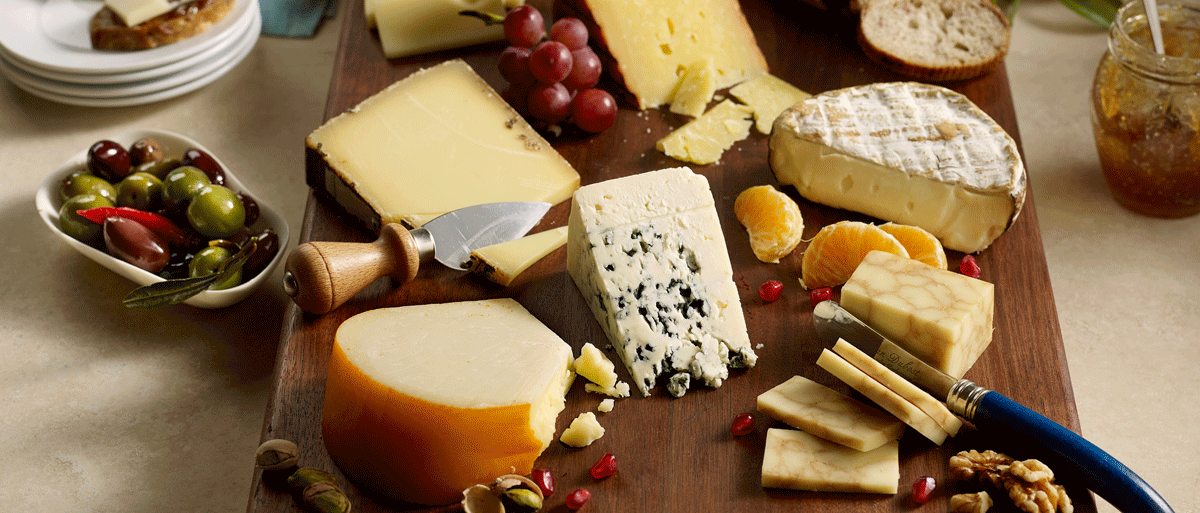According to an ancient legend, the first cheese was unintentionally made by an Arabian merchant who carried his milk in a pouch made from an animal’s stomach. The rennet enzyme in the lining of the pouch combined with the heat of the sun, causing the milk to separate into curd and whey. That night he found that the whey satisfied his thirst, and the cheese (curd) satisfied his hunger.
Cheese has been produced in America since the early 17th Century when English dairy farmers brought their knowledge of dairy farming and cheese making with them from the Old World to the New England colonies. In simplest form, cheese is the concentrated form of milk. There are more than 300 different cheeses in the U.S. today.
Often receiving false negative health claims, a serving of cheese is more nutritious and balanced than commonly interpreted. Cheese contributes quality protein, calcium, phosphorus and vitamin A to the diet. And in many cases, eating cheese with fruits, vegetables and whole grains encourages people to consume more of these healthful foods, helping to improve overall diet quality. Additionally, for those with lactose intolerance, cheese can be an important nutrient source because it is naturally low in lactose. Cheese is a complex and delicious food, made from just four simple and natural ingredients.
Interested in making your own cheese this holiday? The art of cheese making is diverse but the act is quite simple:
- Milk Selection: a specific fat content of milk is selected for the desired cheese being made.
- Coagulation: milk is treated, causing it to separate into curds and whey.
- Drain Whey/ Collect Curd: collected curd is used to make cheese.
- Curd Treatment: curds are cut, salted and pressed to form a cube.
- Processing: some cheeses are cured and ripened, some are processed into other cheese products, and some are sold directly to the grocery store.
This simple process has been manipulated to produce more 2,000 cheese varieties worldwide, most of which fall into these eight categories:
- Blue: a characteristic of varieties that develop blue or green streaks of harmless, flavor-producing mold throughout the interior. Generally, veining gives cheese an assertive and piquant (sharp, tangy, bold, even spicy) flavor.
Examples: Gorgonzola and Danish blue.
- Hard: well-aged, easily grated and primarily used in cooking.
Examples: Parmesan, Romano, Asiago and Swiss
- Pasta Filata: curds are heated and stretched or kneaded before being molded into shape. Stretches when melted.
Examples: mozzarella, string and provolone.
- Processed: a blend of fresh and aged natural cheeses that have been shredded, mixed and heated with an addition of an emulsifier salt, after which no further ripening occurs.
Examples: American cheese and process cheese spreads.
- Semi-hard: a classification of cheese based upon texture.
Examples: colby, cheddar, Edam and Gouda
- Semi-soft: a wide variety of cheeses made with whole milk that melt well when cooked.
Examples: Monterey Jack, brick, Fontina, havarti and Muenster.
- Soft and Fresh: have high moisture content, typically made with the addition of lactic acid cultures.
Examples: cottage cheese, cream cheese, feta, mascarpone, ricotta and queso blanco.
- Soft-ripened: classification of cheese based upon texture.
Examples: brie and Camembert.
Impress your guests this holiday by trying a homemade cheese like our queso fresco or purchase crowd-pleasing fresh cheeses and serve with these seasonal foods:
Holiday Serving and Pairing Ideas
- Serve a blue cheese with a holiday warm apple cider.
- Serve your favorite pasta filata with a platter of sliced apples, dried apricots and water crackers.
- Semi-hard cheeses pair well with homemade jams and jellies. Toasted whole-grain finger sandwiches or crositinis are perfect with semi-hard cheeses, fresh or deli turkey or ham and a raspberry habanero spread.
- Try pairing any semi-soft cheese with warm mustards.
- A warm wheel of soft-ripened brie cheese with a pear or fig jelly is a crowd-pleasing pair for guests.




